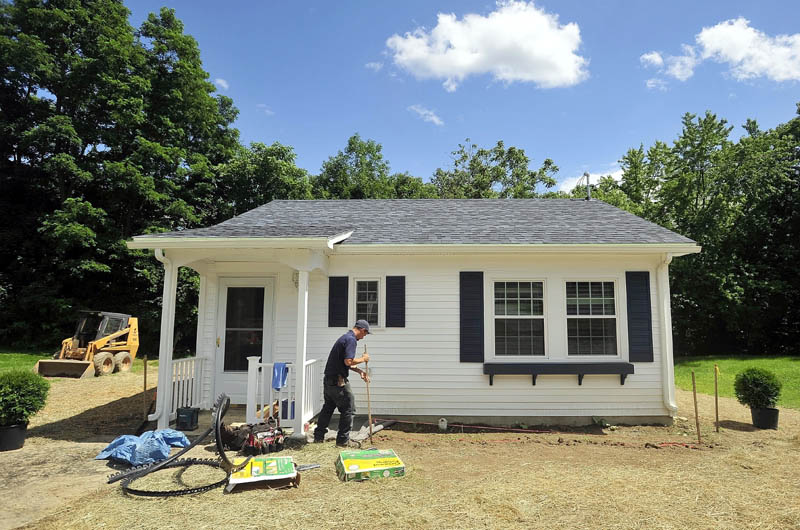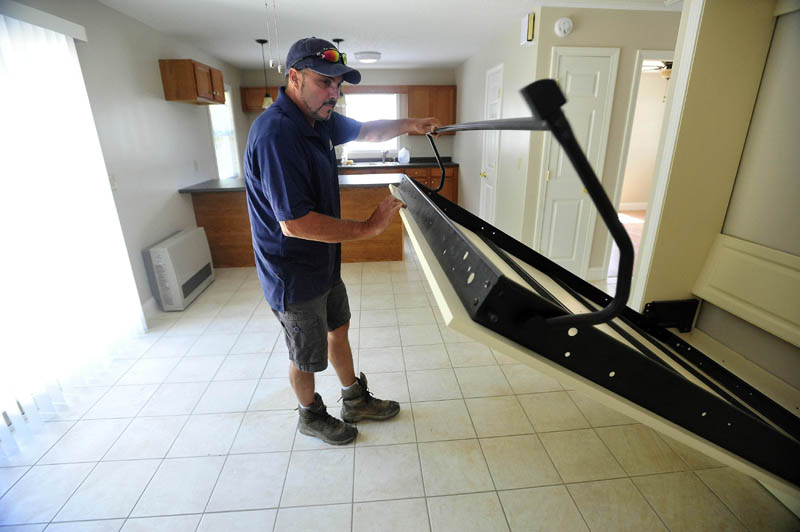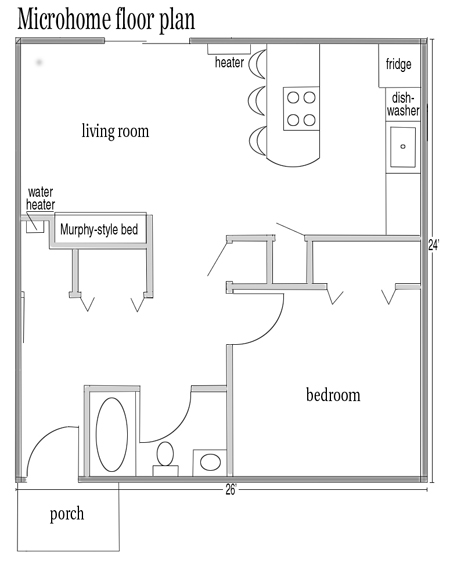WATERVILLE — When home builder Andy Vear shows off his latest project, which he clearly thinks is the coolest home on Cool Street, it doesn’t take much time.
That’s because the house is only 624 square feet, a so-called micro-home that is bucking a national trend toward larger houses. Vear said the smaller housing options, common in the 1950s, are coming back now that a recession has taught many Americans to tighten their belts.
Last week, Vear and his partner, Caleb Albert, completed the tidy white house and set up sprinklers to water new grass seed under a layer of hay. They also put up a sign that sets the price of the home, about the size of a two-car garage, at $89,900.
In his casual clothes and baseball cap, Vear looks more like a workman than like a salesman, but over the course of his 32 years in the home construction business, he often functions as both.
As he guides people from the front door to the back one, a journey of only a dozen paces, his speech is peppered with rapid-fire assertions about the home’s benefits.
To the enthusiastic Vear, when it comes to micro-homes, each advantage is the best advantage.
“It’s inexpensive living,” he said Thursday, pointing out a tankless water heater that will help minimize electric bills. “That’s what it all comes down to, living within your means.”
A few minutes later, while showing off a kitchen pantry built into the wall, he said space efficiency was most important.
“You put a pantry in, you can reduce cabinet size, correct? I mean, storage is everything,” he said.
A minute later, it was something else again.
“The beauty of this house is convenience,” he said. “You’re right on top of everything!”
At 24-by-26 feet, the home is somewhat large for a micro-home, a term for a niche market of tiny homes that sometimes consist of no more than 65 square feet.
But the house on Cool Street is smaller than the average 980 square feet of a trailer home, and much, much smaller than the average Northeastern home, which the U.S. Census Bureau puts at 2,613 square feet. That means that, in the Northeast, there are more square feet per home than in any other region in the country.
The amount is also nearly triple the 983 square feet of the average single-family home built in 1950, according to the National Association of Home Builders.
Vear himself lives in a home that is about 3,500 square feet, more than five times the size of his micro-home, but he said he could see himself living in the cozy house, which features space for a piggy-back washer and dryer; a single 12-by-12 foot bedroom; a storage attic; and the home’s most unusual feature, a Murphy bed. Built into a wall, the bed is designed to swing down into place to accommodate overnight visitors.
The Murphy bed is embedded in one wall of the living room; when it is up, it allows room for a television and a fair-sized piece of furniture, such as a sofa.
Vear said the home will cost about $500 to heat per year, and he estimates a mortgage payment of about $500 a month.
He said homeowners will also save on the maintenance and property tax bills, both of which are scaled down to match the tiny property.
Back to the ’60s
Vear said the micro-homes make sense in a downed economy in which Maine has been stripped of much of its manufacturing industry.
“We’ve gotta go back to the way it was in the ’60s,” Vear said. “You’d normally go small ranches and places with an unfinished upstairs. That’s how everybody started. You live in small homes.”
Data from the U.S. Census Bureau suggests that, while there may be an emerging niche market for micro-homes, little has been done to dampen the American fervor for bigger places to live.
Newly built little houses like the one on Cool Street are becoming more difficult to find in the Northeast, where the number of houses with less than 1,400 square feet has gone down, from 8,000 built in 1999 to just 1,000 in 2012.
The micro-home is even more of an anomaly in Maine, where homes are about 10 percent larger than the country as a whole, and the home-building industry has grown more quickly than the rest of the country.
During the past 20 years, Maine has added about 135,000 housing units, a growth of about 23 percent, which has substantially outpaced the growth rate of about 14 percent of the entire Northeast.
Despite all the statistics pointing to the purchase of larger homes, Vear said his experience has led him to see an opportunity where others see none.
He says it’s a question of economics.
“Does your dollar go as far as it used to? People have less and less money for housing,” he said. “Two ways that you can solve that. Smaller houses. More energy efficient houses. End of story.”
Micro-homes are a new phenomenon in Maine, and are more likely to emerge in more densely populated areas of the state, according to Bart Stevens, president of the Maine Association of Realtors and owner of Century 21 Realty in Winslow.
“We just don’t have a lot of experience with them yet,” he said.
He said the sticker price of about $90,000 will put the micro-home into competition with older, larger houses, but the reduced lifetime costs increase its appeal.
“Smaller homes means it takes less to do everything,” he said.
Stevens said he has noticed a market for less expensive, ranch-style homes that cost less to heat, but he doesn’t think micro-homes are going to become the new normal.
“The novelty will attract potential buyers now,” he said. “We’ll have to see the practicality from there.”
Micro-lot, micro-price
Vear said that, of the 30 or so homes he’s built in his career, some of which have ranged up to a half-million dollars in value, only one has been a micro-home. That one, on Spruce Street, sold in three days, he said.
“If I I had my way, this is all I’d do,” he said. “These are fun to build. People absolutely love them. They come in and they smile.”
While he was building the home, he said, it wasn’t unusual for someone to stop by and ask about it. One person who stopped in has already asked him to build another, under contract.
The lot on Cool Street, which extends down to Messalonskee Stream, is only 56 feet wide, which Vear said caused others in the industry to skip it as unbuildable.
“I see things differently,” he said.
But there are factors that make it difficult to specialize in micro-homes, Vear said. It’s not a lack of interest from buyers. It’s the fact that they come with a lower profit margin.
“In order to make a living at these, I’d have to build five or six a year,” he said.
And the opportunities to build them are limited, he said, in part because municipalities usually have minimum residential lot sizes of 100-by-100 feet, larger than what is ideal for a micro-home.
“To make these houses affordable, you have to have an affordable lot,” Vear said.
Vear, who also sits on the planning board in Winslow, said the town is considering a change to its rules that would allow for what he says is a huge demand for small houses.
As he concluded the tour of the micro-home on Cool Street, Vear’s final thoughts on its most important advantage were likely to be shared by many.
“Price is everything,” he said. “It’s the number one thing people look for.”
Matt Hongoltz-Hetling — 861-9287
mhhetling@centralmaine.com
Send questions/comments to the editors.





Comments are no longer available on this story